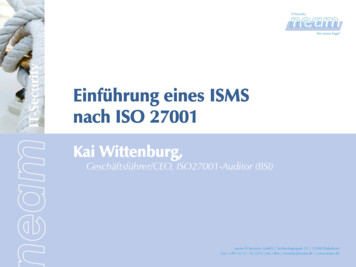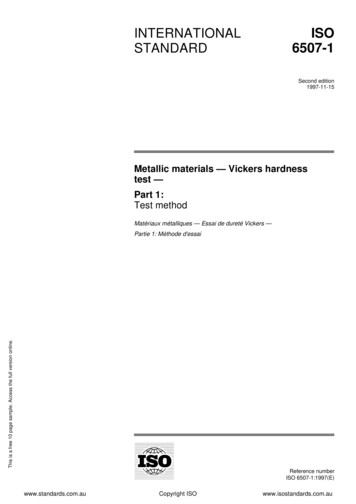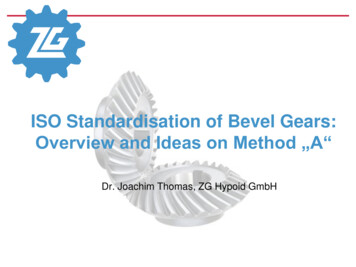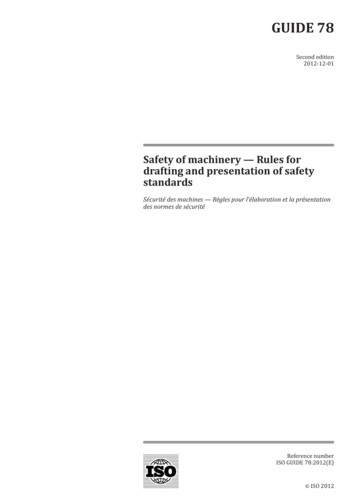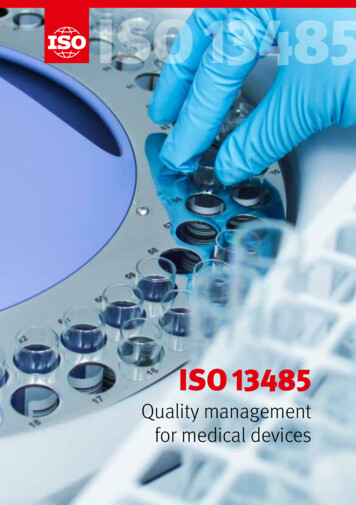
Transcription
Terms and definition in ISO 14001:2015 – where did they originate from?ISO TC 207 SC1 information noteSeptember 2015The revision of ISO 14001:2015 uses ISO Directives Annex SL common terms and core definitions* as well as terms and definitions that arespecific to environmental management. This document sets out in a tabular form the comparison between the terms and definitions in ISO14001:2015, those in ISO 14001:2004, as well as those in Annex SL, and notes the differences.In accordance with ISO rules for the structure and drafting of International Standards, the terms and definitions in ISO 14001:2015 are arrangedin conceptual order relevant to an environmental management system. The numbering of definitions in Annex SL and ISO 14001:2015 is not thesame since the conceptual order is not the same.ISO 14001:2015 includes at the end of the document the alphabetic listing of definitions in English or – if translated – in the language of thetranslated version.The document is available for free download on SC1 website https://committee.iso.org/tc207sc1This document cannot be relied on by organizations seeking accredited certification when it migrates from ISO 14004:2004 to ISO 14001:2015.Page 1*Annex SL version May 2015 refers to Annex SL of the Consolidated ISO Supplement to the ISO/IEC Directives, Part 1, 6th edition, published 1 May 2015 ISO 2015
Terms and definition in ISO 14001:2015 – where did they originate from?ISO TC 207 SC1 information noteSeptember 2015Definition inISO 14001:20153.1 Terms related to organization andleadership3.1.1Nonemanagement systemset of interrelated or interacting elements ofan organization (3.1.4) to establish policiesand objectives (3.2.5) and processes (3.3.5)to achieve those objectivesDefinition inISO 14001:2004Definition inAnnex SL, May 2015*This constitutes one of the commonterms and core definitions for ISOmanagement system standards given inAnnex SL* (3.4).The original definition has beenmodified by modifying Notes 1 and 2 toentryNote 1 to entry: A management system canaddress a single discipline or ional health and safety, energy,financial management).Note 2 to entry: The system elements includethe organization’s structure, roles andresponsibilities, planning and operation,performance evaluation and improvement.Note 3 to entry: The scope of a managementsystem can include the whole of theorganization, specific and identified functionsof the organization, specific and identifiedsections of the organization, or one or morefunctions across a group of organizations.3.1.2environmental management systempart of the management system (3.1.1) usedto manage environmental aspects (3.2.2),fulfil compliance obligations (3.2.9), andaddress risks and opportunities (3.2.11)3.8environmental management system (EMS)part of an organization's (3.16) managementsystem used to develop and implement itsenvironmental policy (3.11) and manage itsenvironmental aspects (3.6)NoneNOTE 1 A management system is a set ofPage 2*Annex SL version May 2015 refers to Annex SL of the Consolidated ISO Supplement to the ISO/IEC Directives, Part 1, 6th edition, published 1 May 2015 ISO 2015
Terms and definition in ISO 14001:2015 – where did they originate from?ISO TC 207 SC1 information noteSeptember 2015Definition inISO 14001:20153.1.3environmental policyintentions and direction of an organization(3.1.4) related to environmental performance(3.4.11), as formally expressed by its topmanagement (3.1.5)Definition inISO 14001:2004interrelated elements used to establish policyand objectives and to achieve thoseobjectives.NOTE 2 A management system includesorganizational structure, planning activities,responsibilities, practices, procedures (3.19),processes and resources.3.11environmental policyoverall intentions and direction of anorganization (3.16) related to itsenvironmental performance (3.10) as formallyexpressed by top managementNOTE The environmental policy provides aframework for action and for the setting ofenvironmental objectives (3.9) andenvironmental targets (3.12).3.1.43.16organizationorganizationperson or group of people that has its own company, corporation, firm, enterprise,functions with responsibilities, authorities and authority or institution, or part or combinationrelationships to achieve its objectives (3.2.5) thereof, whether incorporated or not, public orprivate, that has its own functions andNote 1 to entry: The concept of organization administrationincludes, but is not limited to sole-trader,company, corporation, firm, enterprise, NOTE For organizations with more than oneauthority, partnership, charity or institution, or operating unit, a single operating unit may bepart or combination thereof, whether defined as an organization.incorporated or not, public or private.3.1.5Nonetop managementperson or group of people who directs andDefinition inAnnex SL, May 2015*This constitutes one of the commonterms and core definitions for ISOmanagement system standards given inAnnex SL* (3.7).The original term has been modifiedfrom “policy” to “environmental policy”,and the original definition has beenmodified by adding the phrase “relatedto environmental performance”.This constitutes one of the commonterms and core definitions for ISOmanagement system standards given inAnnex SL* (3.1).This constitutes one of the commonterms and core definitions for ISOmanagement system standards given inPage 3*Annex SL version May 2015 refers to Annex SL of the Consolidated ISO Supplement to the ISO/IEC Directives, Part 1, 6th edition, published 1 May 2015 ISO 2015
Terms and definition in ISO 14001:2015 – where did they originate from?ISO TC 207 SC1 information noteSeptember 2015Definition inISO 14001:2015controls an organization (3.1.4) at the highestlevelDefinition inISO 14001:2004Definition inAnnex SL, May 2015*Annex SL* (3.5).Note 1 to entry: Top management has thepower to delegate authority and provideresources within the organization.Note 2 to entry: If the scope of themanagement system (3.1.1) covers only partof an organization, then top managementrefers to those who direct and control thatpart of the organization.3.1.6interested partyperson or organization (3.1.4) that can affect,be affected by, or perceive itself to beaffected by a decision or activity3.13interested partyperson or group concerned with or affectedby the environmental performance (3.10) ofan organization (3.16)This constitutes one of the commonterms and core definitions for ISOmanagement system standards given inAnnex SL* (3.2).The original definition has beenmodified by omitting the admitted term“stakeholder” and by adding Note 1 toentry and the Example.Note 1 to entry: To “perceive itself to beaffected” means the perception has beenmade known to the organization.EXAMPLE Customers, communities,suppliers, regulators, non-governmentalorganizations, investors and employees.3.2 Terms related to planning3.2.1environmentsurroundings in which an organization (3.1.4)operates, including air, water, land, naturalresources, flora, fauna, humans and theirinterrelationships3.5environmentsurroundings in which an organization (3.16)operates, including air, water, land, naturalresources, flora, fauna, humans, and theirinterrelationNonePage 4*Annex SL version May 2015 refers to Annex SL of the Consolidated ISO Supplement to the ISO/IEC Directives, Part 1, 6th edition, published 1 May 2015 ISO 2015
Terms and definition in ISO 14001:2015 – where did they originate from?ISO TC 207 SC1 information noteSeptember 2015Definition inISO 14001:2015Note 1 to entry: Surroundings can extendfrom within an organization to the local,regional and global system.Definition inISO 14001:2004NOTE Surroundings in this context extendfrom within an organization (3.16) to theglobal system.Note 2 to entry: Surroundings can bedescribed in terms of biodiversity,ecosystems, climate or other characteristics.3.2.2environmental aspectelement of an organization's (3.1.4) activitiesor products or services that interacts or caninteract with the environment (3.2.1)3.6environmental aspectelement of an organization's (3.16) activitiesor products or services that can interact withthe environment (3.5)Note 1 to entry: An environmental aspect cancause (an) environmental impact(s) (3.2.4). Asignificant environmental aspect is one thathas or can have one or more significantenvironmental impact(s).Note 2 to entry: Significant environmentalaspects are determined by the organizationapplying one or more criteria.3.2.3environmental conditionstate or characteristic of the environment(3.2.1) as determined at a certain point intime3.2.4environmental impactchange to the environment (3.2.1), whetheradverse or beneficial, wholly or partiallyresulting from an organization's (3.1.4)environmental aspects (3.2.2)Definition inAnnex SL, May 2015*NoneNOTE A significant environmental aspect hasor can have a significant environmentalimpact (3.7).NoneNone3.7environmental impactany change to the environment (3.5), whetheradverse or beneficial, wholly or partiallyresulting from an organization's (3.16)environmental aspects (3.6)NonePage 5*Annex SL version May 2015 refers to Annex SL of the Consolidated ISO Supplement to the ISO/IEC Directives, Part 1, 6th edition, published 1 May 2015 ISO 2015
Terms and definition in ISO 14001:2015 – where did they originate from?ISO TC 207 SC1 information noteSeptember 2015Definition inISO 14001:20153.2.5objectiveresult to be achievedDefinition inISO 14001:2004NoneNote 1 to entry: An objective can bestrategic, tactical, or operational.The original definition has beenmodified by modifying Note 2 to entryand adding Note 3 to entry.Note 2 to entry: Objectives can relate todifferent disciplines (such as financial, healthand safety, and environmental goals) andcan apply at different levels (such asstrategic, organization-wide, project, product,service and process (3.3.5)).Note 3 to entry: An objective can beexpressed in other ways, e.g. as an intendedoutcome, a purpose, an operational criterion,as an environmental objective (3.2.6), or bythe use of other words with similar meaning(e.g. aim, goal, or target).3.2.6environmental objectiveobjective (3.2.5) set by the organization(3.1.4) consistent with its environmentalpolicy (3.1.3)3.2.7prevention of pollutionuse of processes (3.3.5), practices,techniques, materials, products, services orenergy to avoid, reduce or control (separatelyor in combination) the creation, emission ordischarge of any type of pollutant or waste, inorder to reduce adverse environmentalimpacts (3.2.4)Definition inAnnex SL, May 2015*This constitutes one of the commonterms and core definitions for ISOmanagement system standards given inAnnex SL* (3.8).3.9environmental objectiveoverall environmental goal, consistent withthe environmental policy (3.11), that anorganization (3.16) sets itself to achieve3.18prevention of pollutionuse of processes, practices, techniques,materials, products, services or energy toavoid, reduce or control (separately or incombination) the creation, emission ordischarge of any type of pollutant or waste, inorder to reduce adverse environmentalimpacts (3.7)NoneNonePage 6*Annex SL version May 2015 refers to Annex SL of the Consolidated ISO Supplement to the ISO/IEC Directives, Part 1, 6th edition, published 1 May 2015 ISO 2015
Terms and definition in ISO 14001:2015 – where did they originate from?ISO TC 207 SC1 information noteSeptember 2015Definition inISO 14001:2015Note 1 to entry: Prevention of pollution caninclude source reduction or elimination;process, product or service changes; efficientuse of resources; material and energysubstitution; reuse; recovery; recycling,reclamation; or treatment.3.2.8requirementneed or expectation that is stated, generallyimplied or obligatoryDefinition inISO 14001:2004NOTE Prevention of pollution can includesource reduction or elimination, process,product or service changes, efficient use ofresources, material and energy substitution,reuse, recovery, recycling, reclamation andtreatment.NoneNote 1 to entry: “Generally implied” meansthat it is custom or common practice for theorganization (3.1.4) and interested parties(3.1.6) that the need or expectation underconsideration is implied.Definition inAnnex SL, May 2015*This constitutes one of the commonterms and core definitions for ISOmanagement system standards given inAnnex SL* (3.3).The original definition has beenmodified by adding Note 3 to entry.Note 2 to entry: A specified requirement isone that is stated, for example indocumented information (3.3.2).Note 3 to entry: Requirements other thanlegal requirements become obligatory whenthe organization decides to comply withthem.3.2.9compliance obligations (preferred term)legal requirements and other requirements(admitted term)legal requirements (3.2.8) that anorganization (3.1.4) has to comply with andother requirements that an organization hasto or chooses to comply withNoneNonePage 7*Annex SL version May 2015 refers to Annex SL of the Consolidated ISO Supplement to the ISO/IEC Directives, Part 1, 6th edition, published 1 May 2015 ISO 2015
Terms and definition in ISO 14001:2015 – where did they originate from?ISO TC 207 SC1 information noteSeptember 2015Definition inISO 14001:2015Definition inISO 14001:2004Definition inAnnex SL, May 2015*Note 1 to entry: Compliance obligations arerelated to the environmental managementsystem (3.1.2).Note 2 to entry: Compliance obligations canarise from mandatory requirements, such asapplicable laws and regulations, or voluntarycommitments, such as organizational andindustry standards, contractual relationships,codes of practice and agreements withcommunity groups or non-governmentalorganizations.3.2.10riskeffect of uncertaintyNoneThis constitutes one of the commonterms and core definitions for ISOmanagement system standards given inAnnex SL* (3.9).Note 1 to entry: An effect is a deviation fromthe expected — positive or negative.Note 2 to entry: Uncertainty is the state, evenpartial, of deficiency of information related to,understanding or knowledge of, an event, itsconsequence, or likelihood.Note 3 to entry: Risk is often characterizedby reference to potential “events” (as definedin ISO Guide 73:2009, 3.5.1.3) and“consequences” (as defined inISO Guide 73:2009, 3.6.1.3), or acombination of these.Note 4 to entry: Risk is often expressed inPage 8*Annex SL version May 2015 refers to Annex SL of the Consolidated ISO Supplement to the ISO/IEC Directives, Part 1, 6th edition, published 1 May 2015 ISO 2015
Terms and definition in ISO 14001:2015 – where did they originate from?ISO TC 207 SC1 information noteSeptember 2015Definition inISO 14001:2015terms of a combination of the consequencesof an event (including changes incircumstances) and the associated“likelihood” (as defined inISO Guide 73:2009, 3.6.1.1) of occurrence.3.2.11risks and opportunitiespotential adverse effects (threats) andpotential beneficial effects (opportunities)Definition inISO 14001:2004NoneDefinition inAnnex SL, May 2015*None3.3 Terms related to support andoperation3.3.1Nonecompetenceability to apply knowledge and skills toachieve intended results3.3.2Nonedocumented informationinformation required to be controlled andmaintained by an organization (3.1.4) and themedium on which it is containedThis constitutes one of the commonterms and core definitions for ISOmanagement system standards given inAnnex SL* (3.10).This constitutes one of the commonterms and core definitions for ISOmanagement system standards given inAnnex SL* (3.11).The original definition has beenmodified by modifying Note 2 to entry.Note 1 to entry: Documented information canbe in any format and media, and from anysource.Note 2 to entry: Documented information canrefer to:– the environmental management system(3.1.2), including related processes(3.3.5);– information created in order for theorganization to operate (can be referredto as documentation);Page 9*Annex SL version May 2015 refers to Annex SL of the Consolidated ISO Supplement to the ISO/IEC Directives, Part 1, 6th edition, published 1 May 2015 ISO 2015
Terms and definition in ISO 14001:2015 – where did they originate from?ISO TC 207 SC1 information noteSeptember 2015Definition inISO 14001:2015– evidence of results achieved (can bereferred to as records)3.3.3life cycleconsecutive and interlinked stages of aproduct (or service) system, from rawmaterial acquisition or generation fromnatural resources to final disposalNote 1 to entry: The life cycle stages includeacquisition of raw materials, design,production, transportation/ delivery, use, endof-life treatment and final disposal.[SOURCE: ISO 14044:2006, 3.1, modified ―The words “(or service)” have been added tothe definition and Note 1 to entry has beenadded.]3.3.4outsource (verb)make an arrangement where an externalorganization (3.1.4) performs part of anorganization’s function or process (3.3.5)Note 1 to entry: An external organization isoutside the scope of the managementsystem (3.1.1), although the outsourcedfunction or process is within the scope.3.3.5processset of interrelated or interacting activitieswhich transforms inputs into outputsDefinition inISO 14001:2004Definition inAnnex SL, May 2015*NoneNoneNoneThis constitutes one of the commonterms and core definitions for ISOmanagement system standards given inAnnex SL* (3.14).NoneThis constitutes one of the commonterms and core definitions for ISOmanagement system standards given inAnnex SL* (3.12).Note 1 to entry: A process can bedocumented or not.The original definition has beenmodified by adding Note 1 to entry.Page 10*Annex SL version May 2015 refers to Annex SL of the Consolidated ISO Supplement to the ISO/IEC Directives, Part 1, 6th edition, published 1 May 2015 ISO 2015
Terms and definition in ISO 14001:2015 – where did they originate from?ISO TC 207 SC1 information noteSeptember 2015Definition inISO 14001:20153.4 Terms related to performanceevaluation and improvement3.4.1auditsystematic, independent and documentedprocess (3.3.5) for obtaining audit evidenceand evaluating it objectively to determine theextent to which the audit criteria are fulfilledNote 1 to entry: An internal audit isconducted by the organization (3.1.4) itself, orby an external party on its behalf.Note 2 to entry: An audit can be a combinedaudit (combining two or more disciplines).Definition inISO 14001:20043.14internal auditsystematic, independent and documentedprocess for obtaining audit evidence andevaluating it objectively to determine theextent to which the environmentalmanagement system audit criteria set by theorganization (3.16) are fulfilledDefinition inAnnex SL, May 2015*This constitutes one of the commonterms and core definitions for ISOmanagement system standards given inAnnex SL* (3.17).The original definition has beenmodified by modifying the Notes toentry.NOTE In many cases, particularly in smallerorganizations, independence can bedemonstrated by the freedom fromresponsibility for the activity being audited.Note 3 to entry: Independence can bedemonstrated by the freedom fromresponsibility for the activity being audited orfreedom from bias and conflict of interest.Note 4 to entry: “Audit evidence” consists ofrecords, statements of fact or otherinformation which are relevant to the auditcriteria and are verifiable; and “audit criteria”are the set of policies, procedures orrequirements (3.2.8) used as a referenceagainst which audit evidence is compared, asdefined in ISO 19011:2011, 3.3 and 3.2respectively.3.4.2Noneconformityfulfilment of a requirement (3.2.8)This constitutes one of the commonterms and core definitions for ISOmanagement system standards given inAnnex SL* (3.18).Page 11*Annex SL version May 2015 refers to Annex SL of the Consolidated ISO Supplement to the ISO/IEC Directives, Part 1, 6th edition, published 1 May 2015 ISO 2015
Terms and definition in ISO 14001:2015 – where did they originate from?ISO TC 207 SC1 information noteSeptember 2015Definition inISO 14001:20153.4.3nonconformitynon-fulfilment of a requirement (3.2.8)Note 1 to entry: Nonconformity relates torequirements in this International Standardand additional environmental managementsystem (3.1.2) requirements that anorganization (3.1.4) establishes for itself.3.4.4corrective actionaction to eliminate the cause of anonconformity (3.4.3) and to preventrecurrenceNote 1 to entry: There can be more than onecause for a nonconformity.3.4.5continual improvementrecurring activity to enhance performance(3.4.10)Note 1 to entry: Enhancing performancerelates to the use of the environmentalmanagement system (3.1.2) to enhanceenvironmental performance (3.4.11)consistent with the organization's (3.1.4)environmental policy (3.1.3).Definition inISO 14001:2004Definition inAnnex SL, May 2015*3.15Nonconformitynon-fulfilment of a requirement[ISO 9000:2000, 3.6.2]This constitutes one of the commonterms and core definitions for ISOmanagement system standards given inAnnex SL* (3.19).The original definition has beenmodified by adding Note 1 to entry.3.3corrective actionaction to eliminate the cause of a detectednonconformity (3.15)This constitutes one of the commonterms and core definitions for ISOmanagement system standards given inAnnex SL* (3.20).The original definition has beenmodified by adding Note 1 to entry.3.2continual improvementrecurring process of enhancing theenvironmental management system (3.8) inorder to achieve improvements in overallenvironmental performance (3.10) consistentwith the organization's (3.16) environmentalpolicy (3.11)This constitutes one of the commonterms and core definitions for ISOmanagement system standards given inAnnex SL* (3.21).The original definition has beenmodified by adding Notes 1 and 2 toentry.NOTE The process need not take place in allareas of activity simultaneously.Note 2 to entry: The activity need not takeplace in all areas simultaneously, or withoutinterruption.Page 12*Annex SL version May 2015 refers to Annex SL of the Consolidated ISO Supplement to the ISO/IEC Directives, Part 1, 6th edition, published 1 May 2015 ISO 2015
Terms and definition in ISO 14001:2015 – where did they originate from?ISO TC 207 SC1 information noteSeptember 2015Definition inISO 14001:2015Definition inISO 14001:20043.4.6Noneeffectivenessextent to which planned activities are realizedand planned results achieved3.4.7Noneindicatormeasurable representation of the condition orstatus of operations, management orconditions[SOURCE: ISO 14031:2013, 3.15]3.4.8Nonemonitoringdetermining the status of a system, a process(3.3.5) or an activityNote 1 to entry: To determine the status,there might be a need to check, supervise orcritically observe.3.4.9measurementprocess (3.3.5) to determine a value3.4.10performancemeasurable resultDefinition inAnnex SL, May 2015*This constitutes one of the commonterms and core definitions for ISOmanagement system standards given inAnnex SL* (3.6).NoneThis constitutes one of the commonterms and core definitions for ISOmanagement system standards given inAnnex SL* (3.15).NoneThis constitutes one of the commonterms and core definitions for ISOmanagement system standards given inAnnex SL* (3.16).This constitutes one of the commonterms and core definitions for ISOmanagement system standards given inAnnex SL* (3.13).NoneNote 1 to entry: Performance can relateeither to quantitative or qualitative findings.Note 2 to entry: Performance can relate tothe management of activities, processes(3.3.5), products (including services),systems or organizations (3.1.4).Page 13*Annex SL version May 2015 refers to Annex SL of the Consolidated ISO Supplement to the ISO/IEC Directives, Part 1, 6th edition, published 1 May 2015 ISO 2015
Terms and definition in ISO 14001:2015 – where did they originate from?ISO TC 207 SC1 information noteSeptember 2015Definition inISO 14001:2015Definition inISO 14001:20043.4.11environmental performanceperformance (3.4.10) related to themanagement of environmental aspects(3.2.2)3.10environmental performancemeasurable results of an organization's (3.16)management of its environmental aspects(3.6)Note 1 to entry: For an environmentalmanagement system (3.1.2), results can bemeasured against the organization's (3.1.4)environmental policy (3.1.3), environmentalobjectives (3.2.6) or other criteria, usingindicators (3.4.7).NOTE In the context of environmentalmanagement systems (3.8), results can bemeasured against the organization's (3.16)environmental policy (3.11), environmentalobjectives (3.9), environmental targets (3.12)and other environmental performancerequirements.Definition inAnnex SL, May 2015*Page 14*Annex SL version May 2015 refers to Annex SL of the Consolidated ISO Supplement to the ISO/IEC Directives, Part 1, 6th edition, published 1 May 2015 ISO 2015
Terms and definition in ISO 14001:2015 – where did they originate from?ISO TC 207 SC1 information noteSeptember 2015The following terms and definitions from ISO 14001:2004 do not appear in ISO 14001:2015.Terms in ISO 14001:2004 with no equivalent in ISO 14001:2015 or in Annex SLTerms in ISO 14001:20043.19procedurespecified way to carry out an activity or a processNOTE 1 Procedures can be documented or not.NOTE 2 Adapted from ISO 9000:2000, 3.4.5.3.12environmental targetdetailed performance requirement, applicable to the organization(3.16) or parts thereof, that arises from the environmentalobjectives (3.9) and that needs to be set and met in order toachieve those objectives3.17preventive actionaction to eliminate the cause of a potential nonconformity (3.15)3.20recorddocument (3.4) stating results achieved or providing evidence ofactivities performedNOTE Adapted from ISO 9000:2000, 3.7.6.What has happened in ISO 14001:2015The new concept introduced in Annex SL of ‘documentedinformation’ replaces the terms procedure and records’.Covered as a note in definition of objectives from Annex SL.Covered as part of definition of corrective action which now refersto ‘preventive’.The new concept introduced in Annex SL of ‘documentedinformation’ replaces the terms procedure and records’.Page 15*Annex SL version May 2015 refers to Annex SL of the Consolidated ISO Supplement to the ISO/IEC Directives, Part 1, 6th edition, published 1 May 2015 ISO 2015
*Annex SL version May 2015 refers to Annex SL of the Consolidated ISO Supplement to the ISO/IEC Directives, Part 1, 6th edition, published 1 May 2015 The revision of ISO 14001:2015 uses ISO Directives Annex SL common terms and core definitions* as well as terms and definitions that are



